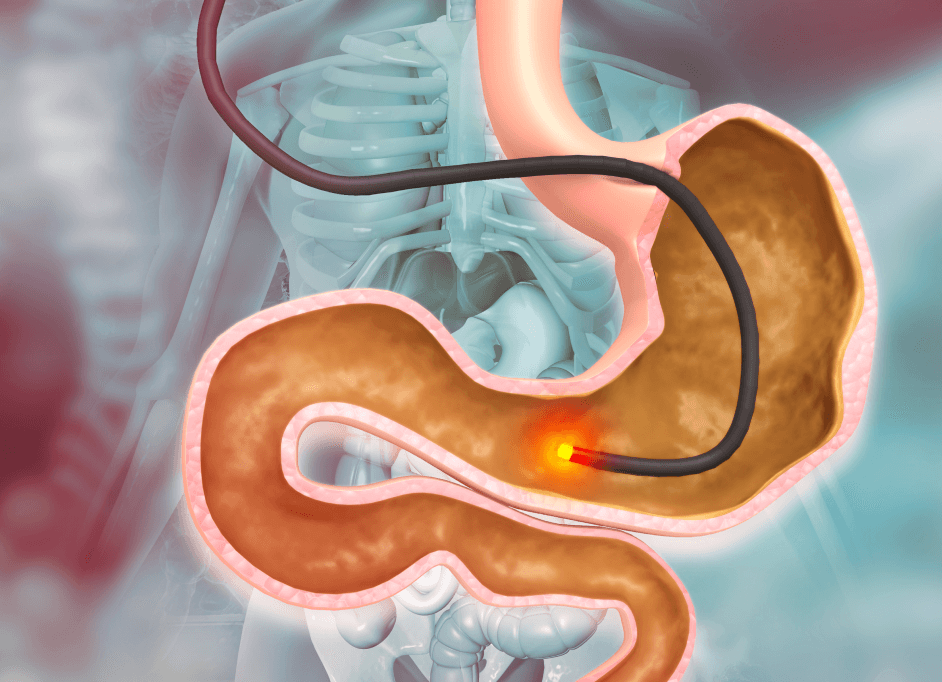

Most of us will experience challenges with our gut health at some point in our life.
Our highly experienced gastroenterologists are experts at managing problems of the gastrointestinal system. This includes the oesophagus, stomach, pancreas, bile duct, liver, small and large intestines, and anus. They perform day surgery procedures and use the latest endoscopic equipment.
When you choose private, you’ll get access to minimal wait times for treatment, and can choose your own gastroenterologist.
For endoscopy services, you’re in good hands at Hunter Valley Private Hospital.


What is endoscopy?
Endoscopy is a medical procedure where a slender camera is inserted into your body by a doctor. This enables them to examine your internal organs to diagnose and treat certain medical conditions.
Endoscopy comes in various forms, such as gastroscopy, colonoscopy, and laparoscopy. The endoscope is inserted through a natural opening or a small incision in your skin.
Typically, endoscopy is conducted under sedation or general anesthesia. It's important to arrange for someone to accompany you home afterward.
For more details on how to prepare for your procedure and what to anticipate post-procedure, consult your doctor.
Conditions
Gastroscopy conditions
- Barrett’s Oesophagus
- Coeliac disease
- Gastro-Oesophageal Reflux Disease (GORD)
- Helicobacter
- Liver Disease, Cirrhosis, Portal Hypertension
- Oesophageal cancer
- Oesophageal Stricture and Dilatation
- Stomach and Duodenal Ulcers (peptic ulcers)
- Stomach cancer
Colonoscopy conditions
- Bowel cancer and polyps
- Irritable Bowel Syndrome
- Ulcerative Colitis and Crohn’s Disease

Procedures
Colonoscopy is a procedure that examines the large intestine, which includes the colon and rectum. It involves using a tool called a colonoscope, a thin, flexible tube equipped with a small camera and light at its tip.
Typically performed with sedation, colonoscopy is usually a day procedure. Before the actual procedure, you'll need to cleanse your bowel with a special preparation drink.
While you're comfortably sedated, the colonoscope is carefully inserted to allow your doctor to inspect your bowel. If any polyps or growths are spotted during the examination, they can be removed and sent for further analysis.
Given the high incidence of colon cancer in our society, regular colonoscopy screenings play a crucial role in prevention. It's worth noting that 99% of colon cancers originate from polyps, making their removal during colonoscopy essential. Although there's a slight risk of bleeding or perforation associated with colonoscopy, these complications are rare, occurring in less than 1% of screened patients.
Thus, colonoscopy is a beneficial and low-risk procedure for cancer prevention. Family members of individuals with colonic polyps or colon cancer are also encouraged to undergo regular screening.
Sigmoidoscopy is a quick procedure designed to examine the lower large intestine using a tool known as a colonoscope. This device is a slender, flexible tube fitted with a small camera and light at its tip.
Flexible sigmoidoscopy can be carried out with or without sedation and is typically done as a day procedure.
Before the procedure begins, a nurse will administer an enema preparation to cleanse your bowel. Then, the colonoscope is gently inserted to allow your doctor to inspect the lower third of your bowel.
If any polyps or growths are identified during the examination, they can be removed and sent for further examination.
Flexible sigmoidoscopy is considered a safe procedure for examining the lower intestine. Complications such as bleeding or perforation are extremely rare.
Upper gastrointestinal endoscopy is commonly referred to as gastroscopy. It's a procedure that examines the esophagus, stomach, and duodenum, which together make up the upper portion of the digestive tract. This procedure involves using a device called an endoscope, a thin, flexible tube equipped with a small camera and light at its tip.
Gastroscopy is typically conducted under sedation and is usually completed within a day. Prior to the procedure, you'll need to fast to ensure your stomach is empty. While you're comfortably sedated, the endoscope is gently inserted to allow your doctor to examine the upper digestive tract. Depending on the observations made during the procedure, biopsies may be taken and sent for further analysis.
Additionally, therapeutic endoscopy techniques may be employed to directly address issues such as bleeding, removal of foreign bodies, or dilation of strictures, as necessary.
Capsule endoscopy is a diagnostic tool used to capture video footage of the small intestine. Unlike conventional endoscopy, reaching the small intestine can be quite challenging due to its lengthy and convoluted nature. With capsule endoscopy, patients simply swallow a capsule about the size of a vitamin pill after undergoing a bowel cleanse. Thanks to its slick coating, the capsule is easily swallowed without the need for sedation.
Capsule endoscopy is known to be beneficial in identifying sources of bleeding within the small bowel, including polyps and small dilated blood vessels known as arteriovenous malformations. Small bowel capsule endoscopy is a non-invasive procedure.
However, it's important to note that capsule endoscopy isn't designed to examine the stomach or colon, which have wider lumens. For a comprehensive evaluation of these areas, gas insufflation via gastroscopy and colonoscopy is required.
ERCP is short for endoscopic retrograde cholangiopancreatography, a specialised method that examines the ducts, often called "drainage tubes" within the gallbladder, pancreas, and liver.
In this procedure, a slender, flexible tube known as an endoscope is carefully inserted through the mouth, passing through the esophagus and stomach, eventually reaching the initial segment of the small intestine. This specific part of the intestine is where the bile and pancreatic ducts join with the intestine. Through the endoscope, a small plastic tube is gently guided into the opening of either the bile duct or pancreatic duct, or both. X-ray dye is then introduced to capture images of these ducts. Occasionally, a minor incision is made in the muscle surrounding the bile duct opening, a process called "sphincterotomy”. This step aims to enhance bile duct drainage or facilitate other necessary procedures, such as gallstone removal, tissue sampling, stent placement (for drainage), or widening of narrowed bile ducts.
To prepare for an ERCP, it's essential to refrain from consuming any food or liquids, including water, typically for six hours before the procedure. Your healthcare provider will provide specific instructions regarding when to commence this fasting period.
Endoscopic ultrasonography (EUS) allows your doctor to explore the interior and exterior of your gastrointestinal tract, including vital abdominal structures like the pancreas and biliary system (encompassing the gall bladder and bile ducts).
This procedure involves using a slender, flexible tube known as an endoscope equipped with an integrated ultrasound probe. Guided by the endoscope, which is introduced through your mouth to the target area, sound waves generate highly detailed visual representations of the digestive tract and abdominal organs. EUS presents an opportunity to administer treatments or collect tissue samples with ultrasound precision, negating the need for procedures conducted through the skin or via open surgery.
Preparation for Endoscopic Ultrasound (EUS) requires you to abstain from food and drink, including water, typically for six hours before the examination. Your healthcare provider will explain this to you in more detail.
GP referral
Talk to your GP for a referral to one of our gastroenterologists today.
